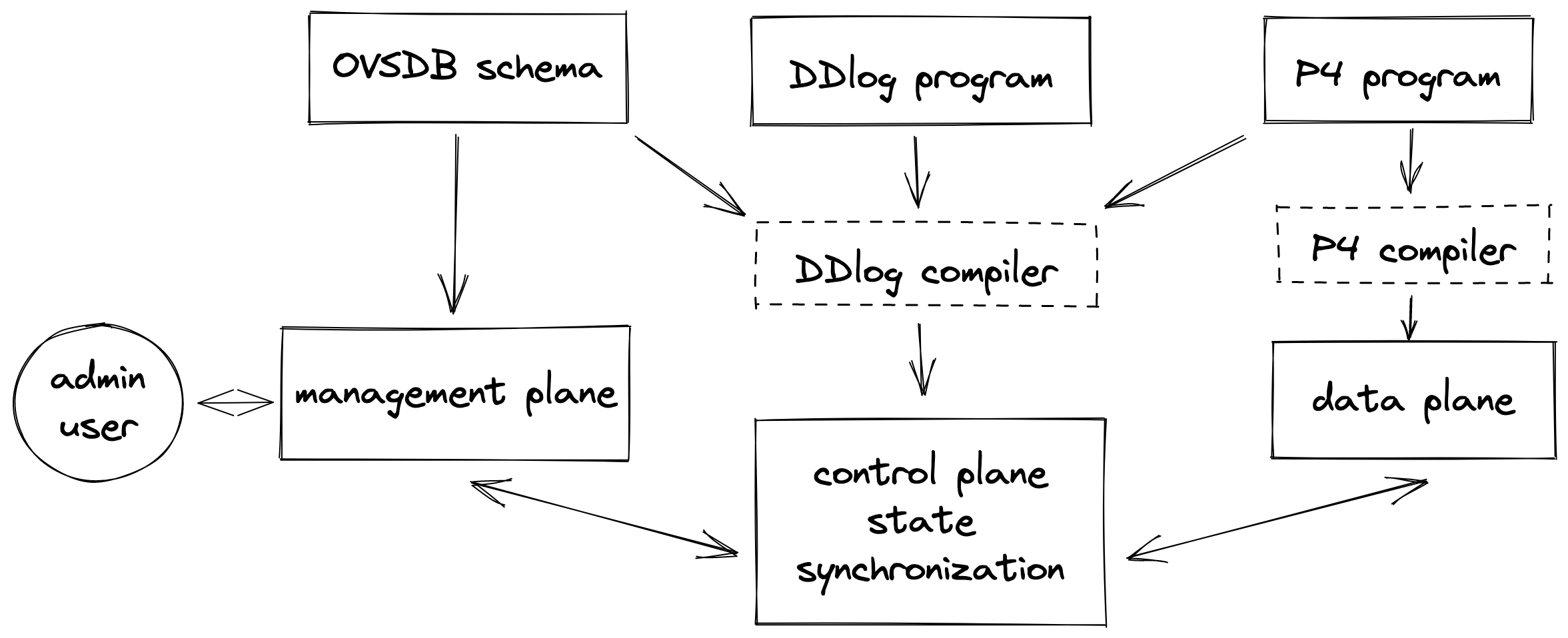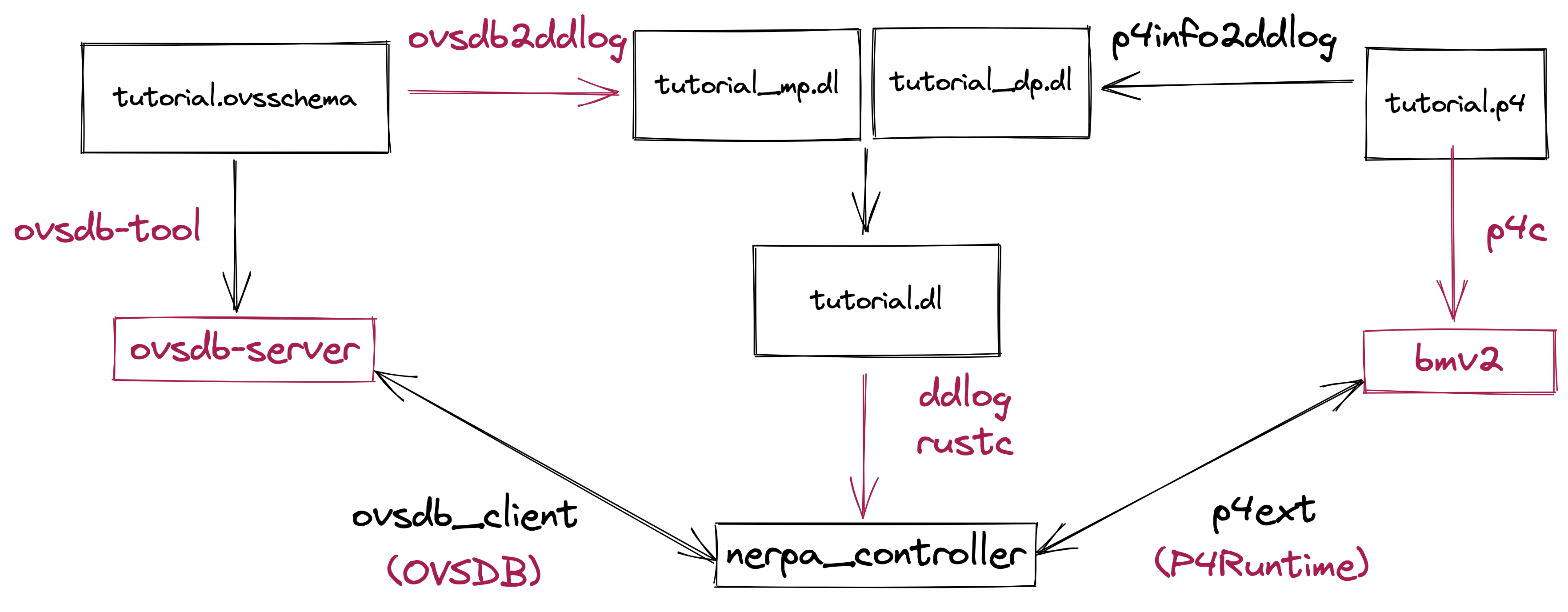Nerpa, short for "Network Programming with Relational and Procedural Abstractions", is a programming framework to simplify the management of a programmable network. It implements an incremental control plane and allows for tighter integration and co-design of the control plane and data plane.
In our current vision for Nerpa, we interoperate between an Open vSwitch Database (OVSDB) management plane; a Differential Datalog (DDlog) program as control plane; and a P4 program for the data plane. This diagram shows how those pieces interact.
The Nerpa framework involves several components, located in different subdirectories. This repo is organized as follows:
- nerpa_controlplane: Each subdirectory corresponds with a Nerpa program, with its input files.
- DDlog program: Serves as the control plane.
- P4 program: Serves as the dataplane program. Used by
p4info2ddlogto generate DDlog output relations. - OVSDB schema: Used to set up an OVSDB management plane. The
ovsdb2ddlogtool uses this to generate input relations. A schema also defines switches, which we add and remove to the network.
-
nerpa_controller: An intermediate Rust program runs the DDlog program using the generated crate. It uses the management plane to adapt the DDlog program's input relations. It also pushes the output relations' rows into tables in the P4 switch using P4runtime. Notice that the controller's
Cargo.tomlis uncommitted. This is generated using thep4info2ddlogtool, to import the correct crate dependencies. -
ovs: Rust bindings to Open vSwitch libraries.
-
p4ext: API above P4Runtime for convenience.
-
p4info2ddlog: Script that reads a P4 program's P4info and generates DDlog relations for the dataplane program.
-
proto: Protobufs for P4 and P4Runtime, used to generate Rust code.
The above pieces fit together as follows in the tutorial Nerpa program:
- Clone the repository and its submodules.
git clone --recursive git@github.com:vmware/nerpa.git
-
Install Rust using the appropriate instructions, if uninstalled.
-
The required version of
grpciorequires CMake >= 3.12. The Ubuntu default is 3.10. Here are installation instructions for Ubuntu. -
We have included an script for Ubuntu that builds all dependencies. This builds all other dependencies and sets necessary environment variables. On a different operating system, you can individually execute the steps. Following the build dependency script's organization ensures compatibility with the build and runtime scripts.
. scripts/build-dependencies.sh
After building all dependencies, you can write Nerpa programs. We recommend following the tutorial for a step-by-step introduction to Nerpa. Individual steps for setup are also documented below.
The Nerpa program called example would consist of the following files. For organization, these files should be placed in the same subdirectory of nerpa_controlplane and given the same name, as follows:
nerpa_controlplane/example/example.dl // DDlog program for the controlplane
nerpa_controlplane/example/example.p4 // P4 program for the dataplane
nerpa_controlplane/example/commands.txt // Initial commands to configure the P4 switch
nerpa_controlplane/example/example.ovsschema // Schema for the OVSDB management plane
These files can also be created using a convenience script: ./scripts/create-new-nerpa.sh example.
In addition to defining the management plane, the .ovsschema is also used for addition and removal of switches on the network.
The switch client configuration has the following fields:
- target - string - hardware/software entity hosting P4Runtime
- device_id - integer - unique identifier for the target P4 device
- role_id - integer - desired role ID for the controller.
- is_primary - boolean - whether or not the client represents the primary device within that role
The (device_id, role_id) pairs should be managed by the user. The user should follow the "arbitration mechanism outside of the server" described in the P4Runtime spec. We recommend reading this section of the spec carefully. This will avoid conflicting configurations and errors when connecting multiple controllers to the P4Runtime server.
It also includes a UUID generated by OVSDB, which is also used as a unique identifier for a specific client.
Once these files are written, the Nerpa program can be built by running the build script: ./scripts/build-nerpa.sh nerpa_controlplane/example example. You can also individually execute the steps in the build script, as long as DDlog has been installed. Note that we do recommend using the build script, so that all software is in the expected locations for the runtime script.
If you are building a new Nerpa program after building a different example (ex., nerpa_controlplane/previous/), you may run into Cargo build errors due to conflicting dependencies. One potential source of errors may be the previous program's DDlog crate. Removing it can resolve these issues:
rm -rf nerpa_controlplane/previous/previous_ddlog.
A built Nerpa program can be run using the runtime script. This script (1) configures and runs a P4 software switch; (2) configures and runs the OVSDB management plane; and (3) runs the controller program.
The runtime script's usage is the same as the build script:
./scripts/run-nerpa.sh nerpa_controlplane/example example
If you did not previously use the scripts that build dependencies and Nerpa, you must ensure that all software dependencies are in the expected locations for the runtime script.
The snvs example program includes an automatic test program to check that the MAC learning table functions as expected. To use it, first build it with:
(cd nerpa_controlplane/snvs/ && cargo build)
Then start the behavioral model with the -s option to enable the automated tests:
scripts/run-nerpa.sh -s nerpa_controlplane/snvs snvs
Once it's started (which takes about 2 seconds), from another console run the tests:
nerpa_controlplane/snvs/target/debug/test-snvs ipc://bmv2.ipc
The test will print its progress. If it succeeds, it will print Success! On failure, it will panic before that point.
Writing and building a Nerpa program involves several steps. We lay those out here for clarity and to reduce pitfalls for new Nerpa programmers. All of these are steps of the build script, scripts/build-nerpa.sh. That script includes specific syntax that you should use if you are rolling your own build process.
-
Create default Nerpa program files: a P4 program, a DDlog program, an OVSDB schema, and P4 switch configuration commands. This is described above.
-
Design the OVSDB schema for the management plane and generate DDlog relations using
ovsdb2ddlog. Note that OVSDB is also used to add switches to the network configuration. -
Write the P4 program. Compile it, making sure to generate P4 runtime files.
-
Generate DDlog relations and related utilities from the dataplane program by calling
p4info2ddlog. Note that running the full build script compiles the stub DDlog program and builds the crate, which can take several minutes.
In order, p4info2ddlog does the following:
- Generate DDlog input relations representing P4 tables and actions
- Generate DDlog input relations representing digest messages from P4
- Generate
Cargo.tomlfor thenerpa_controllercrate, so it correctly imports all DDlog-related crates - Create the
dp2ddlogcrate, which can convert digests and packets to DDlog relations
-
Write the DDlog program. This represents the rules from the control plane. At this point, all relations necessary for import should be generated.
-
Generate necessary files and build the
ovsdb_clientcrate. Even if your program does not use an OVSDB management plane,nerpa_controllerdepends on this import. -
Build the controller crate. The name of the imported DDlog crate does need to be changed before building.
The Nerpa programming framework embeds some assumptions about the structure within P4 and DDlog programs. These are documented below.
-
Multicast: a DDlog output relation meant to push multicast group IDs to the switch must contain "multicast" in its name (not case-sensitive). A multicast relation must have two records, one representing the group ID and one representing the port. The group ID record name should include "id" (not case-sensitive). The port record name should include "port" (not case-sensitive).
-
PacketOut: a DDlog output relation can contain packets to send as PacketOut messages over the P4 Runtime API. Such a relation must be a
NamedStruct, and its name must contain "packet" (not case-sensitive). One of its output Records must represent the packet to send as anArray; its name should include "packet" (not case-sensitive). All other fields represent packet metadata fields in the PacketOut struct (the P4 struct with controller headerpacket_out). -
Modifying a table's default action: Users should not include "DefaultAction" (case-insensitive) in the names of DDlog relations. If a P4 table does not have a constant
default_action, its value can be modified. For tables without a constantdefault_action,p4info2ddloggenerates an output relation with "DefaultAction" in its name. Whennerpa_controllerprocesses an output whose name includesdefault_action, we construct the P4Runtime table entry update following P4Runtime's requirement to modify a default action: a Write RPC with aTableEntrymessage containing an emptyFieldMatchfield. Because this differs from the typical construction of a table entry update, other relations should not include "DefaultAction" (case-insensitive) in their names. That would create errors when updating accompanying P4 table entries. -
Device-specific relations: Relations can be used to update table entries on a specified device. To do this, you can include a field called
client_idof typeintin anoutputrelation. The field's value should be the UUID of the corresponding row in OVSDB'sClienttable. That row is used to configure a client which communicates with the specified device through P4Runtime. Then, if an output relation contains this field,nerpa_controllerwill only write the output to the switch with the expected UUID.


